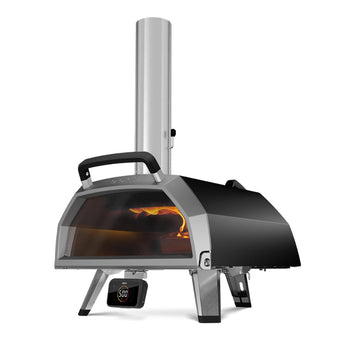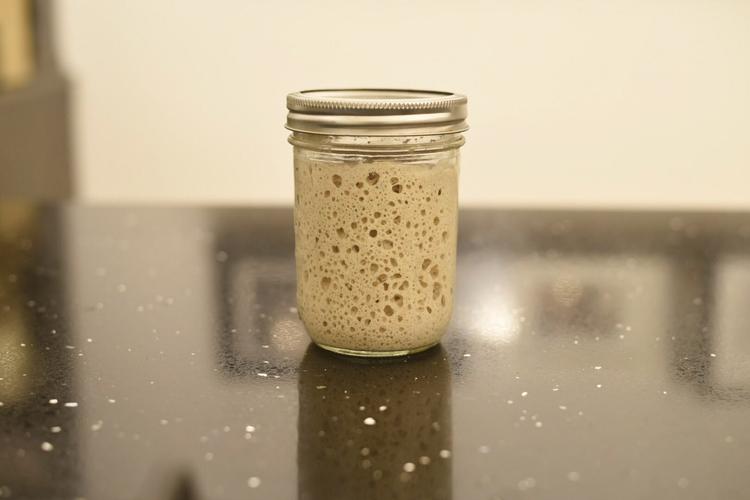We get a lot of questions from Ooni lovers about working with sourdough – like how to make sourdough pizza or sourdough bread. It all starts with having your own sourdough culture – you can often ask a local bakery to have some of theirs, or you can also start one from scratch. Either way, if you’re keen to start working with all sorts of sourdough recipes, follow this A-Z guide on making and maintaining a sourdough starter!
What is sourdough?
Sourdough is a traditional method of making dough that uses a natural starter, or mother, to ferment any kind of dough, rather than using commercial, ready-made yeast that comes from a packet. It means the dough takes longer to prove and develop, and you get a great depth of flavour in your doughs. You can use the sourdough method for making anything from bread to pizza to English muffins!
How to make a sourdough starter
Before you can start baking with a sourdough starter, you need to have one on hand. Bakeries that work with sourdough are often happy to share a bit of their starters with baking enthusiasts – just ask your local for a little and nurture it! Or, if you’d like to prepare your own starter from scratch, here’s how to do that.
To make a sourdough starter, all you need is flour and water. It’s best to start with good quality ingredients that are as free from contaminants as possible.
You can use any kind of flour, but each will behave slightly differently. We recommend starting with reliable all-purpose flour. Once your starter has matured, you can use it to help grow a whole range of different flour sourdough starters, from rye to buckwheat!
Equipment
1.5L (2 quart) glass container
Large spoon
Tea towel, plastic wrap or the container lid
Rubber band
Ingredients
575g (20oz) warm water (about 70°F / 21°C)
Note that preparing your own starter typically takes around 5 days, because the mixture needs time to develop enough yeasts and bacteria to become sour and produce those signature frothy bubbles, so be sure to start well in advance of when you’d like to make your first sourdough recipe. The above ingredients are the total amounts that will be needed for preparing the starter over a 5-day period.
Step 1 - mix and ferment
Add the flour and water into the container, and use the spoon to mix together, making sure to work some air into the mixture. Mix well until it forms the consistency of a thick batter. Scrape any excess off the sides of the container, and cover the container with the lid, towel or plastic wrap – it should only be loosely covered – and keep the towel/plastic wrap in place with a rubber band.
Leave the container to ferment somewhere that has a consistent room temperature for 24 hours.
Step 2 - feed the starter
It’s now time to start feeding the starter to spur on the fermentation process. Add another 115g (4oz) of all-purpose flour and 115g (4oz) of warm water to the container, and again mix well until thoroughly combined. Scrape down the sides and loosely seal again as before, leaving to rest for a further 24 hours.
Step 3- feed and grow!
The next day (you should now be on day 3 of your sourdough starter), take 230g (8oz) of your starter mixture and pour it into a clean jar. You can discard the remaining mixture or use it for recipes that call for “sourdough discard”.Grab your new jar containing 230g (8oz) of starter mixture, and add 115g (4oz) of all-purpose flour and 115g (4oz) of warm water. Stir to mix and loosely cover for 24 hours. Repeat the same process of discarding and feeding in a fresh jar every 24 hours for the next two days.
If after this five day process you don’t think you’re seeing enough bubbles or the starter doesn’t smell strongly sour just yet, you can continue feeding it for another couple of days. The fermentation may be a little slower in your home due to the ambient room temperature where you’re leaving your starter for each 24 hour period of fermentation.
Maintaining your sourdough starter
No matter what kind of dough you’re making – whether it’s for pizza, bread or anything else – a key part of prepping sourdough-based recipes is maintaining your sourdough starter, so that it’s always alive and ready to activate for using in a recipe.
Keep your starter in a glass jar on your kitchen countertop, covered loosely with a lid, or with a cloth with a rubber band to keep it in place.
If you’re using your starter regularly to make dough, it’s best to feed it with equal parts water and all-purpose flour every 1-2 days to keep it alive and active, so it’s ready to use anytime.
To feed the starter, simply add equal parts flour (the same flour your starter is based on) and warm water and mix until fully incorporated. Be sure to always use the same type of flour to feed the starter as the type of flour that was first used to build the starter. If you want to start working with different flours, scroll down to read about that! The starter will grow every time you do this, so before adding the fresh flour and water each time you’ll need to remove some of the starter before adding the fresh flour and water. Depending on the size of the glass jar you’re using, you can remove up to half of the active starter before adding the fresh flour and water.
This will keep your starter active and ready to go – to use it in a recipe, simply use the amount of active starter called for in the recipe, ie. the bubbly starter that was fed 1-2 days ago, before you add the fresh flour and water. If the recipe you want to make calls for more sourdough starter than you have on hand, you can add some of your active starter to a larger container and start feeding it equal parts flour and water over a period of days in order to grow it to the size needed for that recipe.
Storing your starter when you can’t feed it
Creating a new starter with a different type of flour
To do this, take 20g (¼ cup) from your active all-purpose starter, and add to another glass jar. Then, follow the steps above for making a sourdough starter using equal parts of your flour of choice and warm water. Adding a bit of your already active starter to build the new starter will help to kickstart the fermentation!







